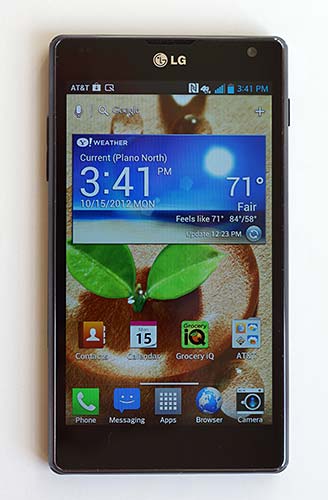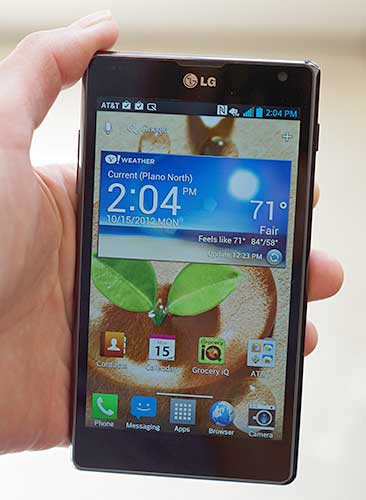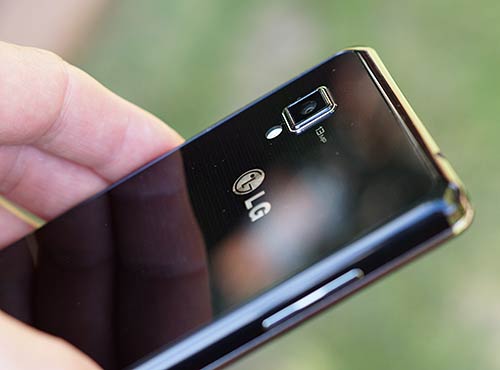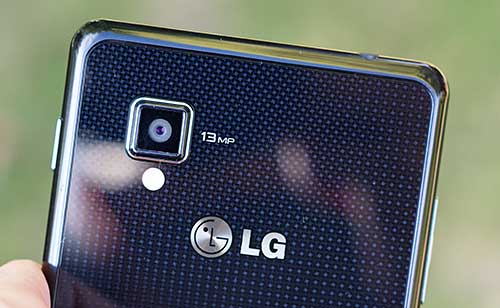LG Optimus G Review
11:22
The LG Optimus G; it's hard not to be smitten even
if you're not an LG fan. This high end Android smartphone is the first
to ship with Qualcomm's new Snapdragon S4 Pro quad core 1.5GHz CPU with
Adreno 320 graphics. It's fast, yes it is. The S4 dual core matched
NVidia's Tegra 3 CPU on benchmarks, so we're excited to see what two
more cores can do. In fact, it scored 7235 on the Quadrant benchmark,
which is a new record for a stock Android phone (5,000 is the norm for
the fastest phones and tablets). In this review we look at both the
AT&T (LG-E970) and Sprint (LG-LS970) versions of the Optimus G,
which sells for $199 with contract. The AT&T version will be
available on Nov. 2 while the Sprint version will be available on Nov.
11.

The AT&T LG Optimus G.
The LG Optimus G has a front 1.3MP
camera, dual band WiFi 802.11b/g/n, Bluetooth 4.0, a GPS, NFC and a 2100
mAh Lithium Ion battery that's sealed inside. Both models have 2 gigs
of RAM. Though LG's track record for Android OS updates hasn't been
impressive, we have hope for the Optimus G since LG is rumored to
release the next Nexus phone (with similar specs to the Optimus G), and
that should put them on a faster track for OS updates.

The Sprint LG Optimus G.
Design and Ergonomics
The smartphone has a gloss patterned
"Crystal Material Finish" glass back that loves fingerprints. LG strove
to marry the best of the iconic LG Chocolate and Prada phones with the
minimalist, square black design. It's thin and squared-off, and the
Sprint version re-introduces some of those chrome accents AT&T
suppresses with their clean design. Honestly, both look quite nice but
not as strikingly chic as the HTC One X, Nokia Lumia 900 or iPhone 5.
Both the Sprint and AT&T versions
are very similar, with the same Optimus UI enhancements on top of
Android OS 4.0.4 Ice Cream Sandwich (4.1 Jelly Bean will follow with no
set date). How do they differ? The Sprint version has that slim chrome
ring around the sides and no SIM card or microSD card slot. The Sprint
version has 32 gigs of internal storage vs. 16 gigs on the AT&T
model. Sprint sticks with the 13MP rear camera while AT&T moves down
to a still very capable 8MP camera. AT&T adds a microSD card slot
(yes!) and includes a 16 gig card. The Sprint and international versions
have no SD card slot.

The Sprint version of the Optimus G is a
hair taller and narrower. Honestly, they're extremely close in
dimensions. Both phones feel fairly wide among today's big phones in the
hand thanks to the slightly wider than normal display, though in terms
of dimensions they're similar to other big phones. If you have small
hands, neither will be comfortable. I have large hands, so the G is
manageable though perhaps not optimal for one-handed use. While Samsung
and HTC taper the corners and sides of their big phones to make them
look and feel smaller, LG's unabashed rectilinear design does nothing to
fool the mind or hand into thinking you've got a smaller phone. If the
iPhone 5 and Motorola Droid RAZR M with their 4" displays are your idea
of ergonomic perfection, the LG Optimus G will feel unwieldy.
Both the Sprint and AT&T versions
have controls and ports in the same location. The power button is at the
upper right edge and the volume controls are on the upper left, similar
to Samsung Android phones. The AT&T version has a tri-color LED
ring around the power button rather than the front face, which I prefer.
The micro USB port is on the bottom on both models, and the 3.5mm
stereo audio jack is up top. The camera module on the Sprint version
protrudes a bit while the AT&T model's is flush with the casing.
Both have a loudspeaker that fires from the lower right rear of the
phone, where your hand might cover it.
720p IPS Display
The LG Optimus G features a 4.7" True HD
IPS Plus display running at 1280 x 768. That's a little higher than the
usual high end 1280 x 720 resolution, and that equals an impressive 320
dpi. LG makes excellent IPS displays and the Optimus G's is very sharp
and colorful with neutral color balance and very clear text. Viewing
angles are wide since it's IPS and the display is bright, though glare
is still an issue outdoors as with all smartphones thanks to the glossy
glass. The display is fused directly to the glass, so you don't feel
like there's a window pane between you and what's on screen. The Optimus
G has Gorilla Glass for durability. I'd give the HTC One X's excellent
Super LCD display an edge for viewing angles and glare-reduction, as
well as a more "close to the surface" look where text and images seem
painted on the screen. Likewise, the iPhone Retina display looks sharper
and more immediate, but the Optimus G easily beats out the Samsung
Galaxy S III display.
Performance and Horsepower
OK, geeks, this is where the LG Optimus G currently beats every other Android smartphone on the planet. The quad core Qualcomm Snapdragon S4 Pro 1.5GHz CPU has more spare CPU cycles than you can imagine. Seriously, it's too bad there's no way to donate some processing power to Project SETI@home. LG incorporates quite a few visual effects and frivolous but entertaining features like the ability to play a video on top of any app, with adjustable transparency, and the phone still doesn't skip a beat. The Optimus G scores a new record high on the Quadrant benchmark and it does extremely well on most other benchmarks. More important than synthetic tests, it feels fast and doesn't bog down quickly when several apps are running in the background. Today's most demanding 3D gaming titles play fluently (watch our video review to see them in action), and 1080p video plays smoothly. That said, the screen is 720p, so there's no point to playing 1080p video unless you want to take advantage of the Optimus G's MHL video out to an HDMI 1080p TV or monitor.Software
LG has gone to town with software
features that make use of the Qualcomm Krait's processing and graphics
power. QSlide lets you play a movie over any other app and you can set
the transparency level (fade out to read a text message, then fade back
in to your video). You can zoom when playing videos (in fact you can
pinch zoom everywhere) and there are several spiffy transition options
for page turns in the homescreen UI. QuickMemo lets you take notes
anywhere at any time, and you can even mark up a web page or Word
document and save it as an image (screen shot). There are a few features
that remind us of Samsung's, like Wise Eye that checks to see if you're
looking at the screen so it won't turn off and the water sound effect
in the lock screen. Smart Shutter lets you take a photo using your voice
(say "cheese", "kimchi" or other trigger words). You get the idea:
there's a lot going on here.
Phone and Data
Both versions have clear incoming and
outgoing voice that's above average, though not quite as crystal clear
and full as the Samsung Galaxy S III, HTC One X and HTC EVO 4G LTE. We
had absolutely no trouble engaging in conversations with call recipients
and ambient noise rejection was effective with minimal digitization.
Though we're in a supposed Sprint
LTE coverage area, none of our Sprint phones have picked up an LTE
signal, leaving us with meager 3G coverage for data. The Sprint version
averaged 600 kbps for download speeds, which is very low compared to the
big three national carriers but par for the course on Sprint. With the
AT&T model, we saw speeds that are slightly below typical for 4G LTE
on AT&T (16Mpbs down and 14Mpbs up according to Ookla's
Speedtest.net app). Reception on both models in decibels was the same as
other top Android phones on their respective carriers.Camera
As noted, the Sprint Optimus G sticks with
the impressive 13 megapixel rear camera that we first saw in the
overseas version. Though some reviewers have reported hazy photos with
the Sprint model, ours have been nothing but sharp with plenty of
detail.
The AT&T model has an 8 megapixel
camera that's quite capable, though we noted the 13MP camera captured
more fine detail and did a better job focusing and creating sharper
images for low light indoor shots (see guitar photo below). It's a close
race, but I'd give the Samsung Galaxy S III and the HTC One X (not to
mention that photographic monster the Sony Xperia Ion) the edge for photo and video quality.
Both models can shoot 1080p video up to
30fps and have HDR, panorama mode and an intuitive camera app with
myriad features and settings.
Battery Life
The Optimus G has a 2100 mAh Lithium Ion
battery that's sealed inside. That's the same battery capacity you'll
find on other high end competing phones, but the LG lagged behind by 30
minutes in actual use tests. Standby on the other hand was excellent. We
had no trouble making it through the day with light to moderate use. In
fact with light use we managed 2.5 to 3 days on a charge. But with
heavy use that included a few GPS navigation sessions, 45 minutes of
streaming video, several phone calls, an hour of music playback with the
screen off and an hour of locally stored video playback, the phone went
from 7am to 7pm before it drained to a 10% charge.




0 comments